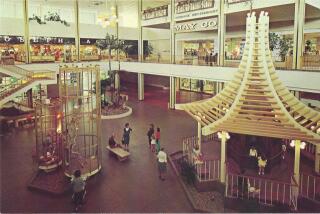Book Review : Focusing on New Walls and Malls of the Cities
- Share via
The Malling of America by William Severini Kowinski (Morrow: $17.95)
Through most of history, the focal point of cities has been the market, a designated area where farmers, craftsmen, artisans, entrepreneurs, consumers and the curious could gather to barter, buy, trade and sell produce, goods and services, be entertained, socialize, politic and generally indulge themselves in the emerging civilization of the period.
And as the fortunes of markets have waxed and waned, so have the fortunes of the cities where they are located and their civilizations. Indeed, the markets in their various forms over the centuries--from carts in a field and stalls in a church plaza to shops along a main street and department stores downtown--could be considered the most revealing product of the various civilizations mankind has suffered.
As William Severini Kowinski notes, the most dominant form of the market in the United States today, and most likely throughout the industrial world tomorrow, is the ubiquitous mall, those well-packaged, easily accessible, climate controlled, nondenominational cathedrals of consumerism. He adds that over the last quarter of a century, malls have become the new centers of many of our communities, the places where people not only go to shop, but to be entertained, to see and be seen, perhaps eat, take a class, attend church, marry, have a child, get divorced and generally live out their lives.
In an engaging personal style, Kowinski tours select malls across the country to sketch an informal portrait of their planning, development, operations, management and packaging to create a secure, slick environment. It is a tour that--despite a striving, witty and observant guide--tends to bore; once you’ve visited a few malls on the sliding socioeconomic scale, you’ve just about seen them all.
Kowinski’s observations also tend to be a bit sweeping, lumping the rise of adult theme parks, such as Faneuil Hall in Boston and Ghiradelli Square in San Francisco, with the more traditional suburban malls his main focus. A little less description and a little more perspective would have been helpful in explaining how the present form and location of malls evolved; how, by controlling their environment and crowds through design, they offer the same security that the walled cities and the well-policed downtowns of the past offered; how the malls followed the shift in populations to suburbia and how they cater to the rise of the private automobile, and what effect these shifts have had on the nation’s cities.
Still, Kowinski’s description reveals much about the present values shaping and misshaping the country today. We are indeed being “malled,” as the book’s double-entendre title indicates, especially those of us who yearn for the ambiance of the markets of yesteryear that lent a community a sense of place.
More to Read
The biggest entertainment stories
Get our big stories about Hollywood, film, television, music, arts, culture and more right in your inbox as soon as they publish.
You may occasionally receive promotional content from the Los Angeles Times.










